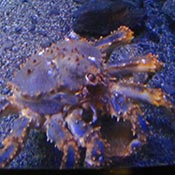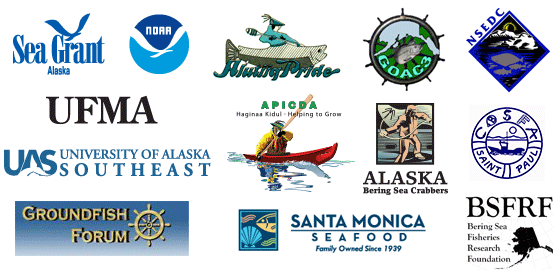King crabs on display at Alaska SeaLife Center
 A blue king crab on exhibit at the Alaska SeaLife Center. Photo from Caitlin DeGrave. Click image for larger version [1.8 MB].
A blue king crab on exhibit at the Alaska SeaLife Center. Photo from Caitlin DeGrave. Click image for larger version [1.8 MB].AKCRRAB researchers collect female crabs from the field each year to raise their young at the hatchery. One advantage is that since the female selects her mate in the wild, the larvae produced are not domesticated. AKCRRAB research biologists donated female red king crabs from Kodiak and blue king crabs from St. Matthew Island to the Alaska SeaLife Center (ASLC) in summer 2013 after the larvae hatched. The larvae were used in larval and juvenile rearing experiments, including the first experimental release in Kodiak in fall 2013.
The adult female blue king crabs are now housed in an exhibit at the Alaska SeaLife Center that features several species found in the Bering Sea. The adult female red king crabs are in holding tanks at the ASLC for use in a future display and can be viewed during behind-the-scenes tours.
Adult female red king crabs from Juneau, also collected for AKCRRAB research, were donated to the Living Planet Aquarium in Sandy, Utah, outside of Salt Lake City. A new 1,800 gallon exhibit starring Alaska king crabs is slated to open there in January 2014.
These adult crabs are serving an important educational role in Alaska and Utah. AKCRRAB leaders plan to continue partnerships with public aquaria in this important outreach effort.
News Flash is edited by Asia Beder and Ginny Eckert. AKCRRAB, the Alaska King Crab Research, Rehabilitation and Biology Program, is sponsored by Alaska Sea Grant, UAF School of Fisheries and Ocean Sciences, NOAA Fisheries, the Alutiiq Pride Shellfish Hatchery, community groups, and industry members.

